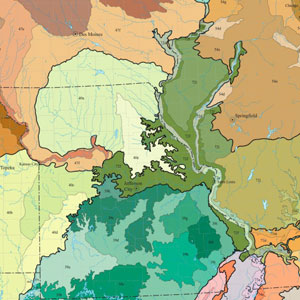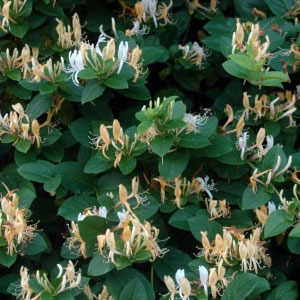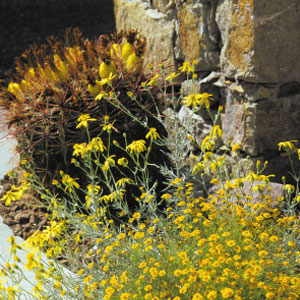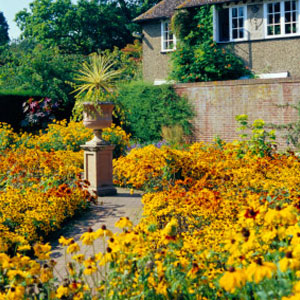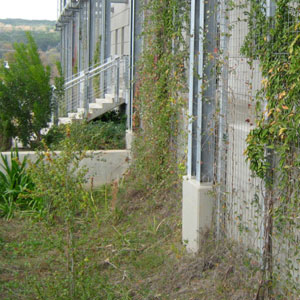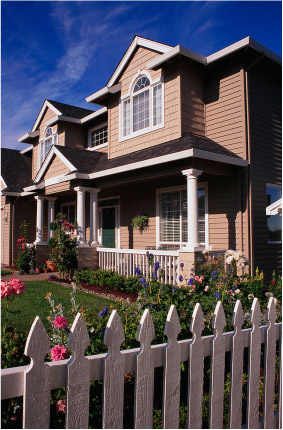
Most residential dwellings could improve energy conservation when it comes to climate control. Image credit: Microsoft Images
Use Vegetation to Increase Energy Efficiency
Houses use 22 percent of the energy consumed in the United States today. About half of this is for heating and cooling. A properly designed landscape can make a home significantly more energy efficient and reduce air pollution, including greenhouse gases. It can also cut heating and cooling bills by as much as 40 percent.
An energy-conserving landscape utilizes trees, shrubs, groundcovers and vines to provide cooling summer shade as well as insulation against heat loss in winter. It also serves aesthetic purposes. A windbreak, for example, can define the space in a yard or patio and provide privacy while blocking blustery winds. And by using plants as living air conditioners or insulating blankets, you can soften a house’s architectural edges with foliage and flowers while improving its performance.
Know your climate region.
Energy saving strategies for buildings are in large part determined by geographic location. The U.S. Department of Energy has divided up the United States into four climate regions — cool, temperate, hot and arid, and hot and humid — and has recommended these landscaping strategies for each zone:
Cool
- Use windbreaks to protect buildings from cold winter winds.
- Avoid planting tall vegetation on the south side of the house that may prevent the sunlight from reaching walls or windows.
- Shade south and west windows and walls from the direct summer sun if summer overheating is a problem. Deciduous plants can be used to provide summer shade while allowing low-angle winter sunlight to warm your home during the coldest months.
Temperate
- Locate vegetation so that it does not block the winter sun.
- Locate vegetation so that it shades the roof, east and west facing walls.
- Deflect winter winds away from the house.
- Funnel summer breezes toward the house.
Hot and arid
- Provide shade to cool roofs, walls and windows.
- Landscape around your home so that it is cooled by evapotranspiration, the release of water vapor from the soil and plant surfaces into the atmosphere.
- Funnel summer breezes toward your home if it is cooled naturally and does not rely upon air conditioning.
- Deflect wind away from houses that are air-conditioned.
Hot and humid
- Direct summer breezes toward the house.
- Make the most of summer shade with trees that allow low-angle winter sunlight to warm the home.
- Avoid locating planting beds close to the house if they require frequent watering.
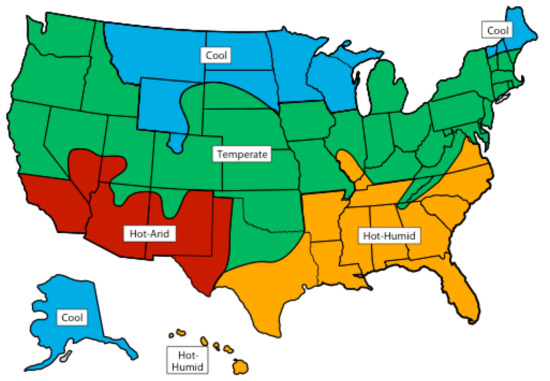
The U.S. Department of Energy’s four climate regions help homeowners determine best landscaping practices. Image credit: Landscape For Life

Trees and shrubs provide shade around a Texas home. Image credit: Sally and Andy Wasowski
Landscape for energy efficiency.
How to reduce air-conditioner use in the summer months:
- Shade air-conditioner units. According to the Department of Energy, this can increase a unit’s efficiency by as much as 10 percent. Just be sure that shrubs or vines planted near the compressor do not obstruct the airflow or impede access for repairs.
- Shade all windows that receive direct sunlight. A building gains substantially more heat through windows than insulated walls, making the shade a priority in the summer months.
- Shade east- and west-facing walls and the roof. During the summer months, the location of the sun shifts slightly to the north and the roof and east- and west-facing walls receive the most sunlight. Prevent overheating early in the day by shading east and southeast building surfaces; reduce peak indoor temperatures and accelerate afternoon and evening cooling by shading west and southwest walls and roof.
- Shade heat sinks such as dark-colored driveways, roadways or patios. Dark paving and roofing materials such as asphalt roads, roofs and driveways absorb and radiate significant amounts of heat into surrounding materials and air masses. The warm air can influence the inside temperature of a home and the comfort level of people in the landscape. Shading these surfaces, particularly during the months of the year when overheating is a concern, is an important urban heat island mitigation strategy that will not only benefit the site but also the surrounding area.
Use Vegetation to Provide Shade
A variety of beautiful vines, shrubs and trees with appropriate sizes, densities and shapes are available for almost any shading application. To block solar heat in the summer but let much of it in during the winter, use deciduous trees. To provide year-round shade in hot climates, use evergreen trees, shrubs and vines.
Vines
Trees often grow slowly, but homeowners can moderate hot sunshine quickly using vines that clamber up strategically placed trellises. Permanent structures such as trellises are most appropriate in hot climates where blocking solar heat gain in winter is not counterproductive. Where wetness and humidity are a problem, keep the trellis at least a foot away from the house to allow for air circulation; in these areas air should be allowed to flow around the home, keeping the structure and surrounding soil dry to prevent mildew and rot. Arbors or pergolas can help shade windows, too, and are a better choice in temperate regions if the lower winter sun can still penetrate the windows to warm the house.
Annual vines grow quickly and can cover a large area by mid to late summer. Homeowners can make shading devices twice as functional by growing vines that not only provide shade but also fruits or vegetables. Edible vines such as scarlet runner beans, winter squashes and luffa squashes are both vigorous and fast growing. Ornamental vines are also good candidates, especially if they offer food and shelter for wildlife. Cypress vine and scarlet creeper provide nectar for hummingbirds, for example, while moonflower attracts moths. At the same time, homeowners can plant perennial vines, which may take two or more years to cover an arbor or trellis as tall as the home’s walls. But unless they don’t block the sun in winter or can be cut back drastically at the end of the season, avoid planting these in cooler climates where solar heat gain is desirable during the cold months.
Trees and Shrubs
Large trees and shrubs take longer to fill in but provide the best cooling shade. The air temperature can be as much as 25 degrees Fahrenheit cooler under trees than around nearby asphalt lots. As is true for vines, in cool and temperate climates placing trees for summer shade and winter sunshine is more complicated than it would first appear. Trees can reduce summer temperatures significantly, especially when they’re located on the south and west sides of a house. Large specimens that shade the roof and walls from the afternoon sun can reduce indoor temperatures by as much as 8 to 10 degrees Fahrenheit. Trees should be located close enough to the house to cast shade but far enough away (typically about 15 feet) that their roots will not damage the foundation. Homeowners should also consider how wide the trees will become when mature, and space them accordingly.
On small city or suburban lots, the optimum location for a shade tree may be in the neighbor’s yard. Homeowners should work with neighbors to plan and plant an energy-conserving neighborhood landscape that improves conditions and lowers costs for everyone. If that’s not possible, homeowners can use shrubs and vines to shade the walls, windows and air conditioner.
Deciduous trees provide shade in summer, then drop their leaves in autumn, allowing the warmth of the sun to filter through their bare branches and help heat the home when the weather is cold. Maples and other tall species with broad leaves and a high, spreading crown are ideal for this purpose. As few as two or three properly spaced trees with wide crowns may suffice, depending on the size of the house. Prune lower branches for maximum heating of walls and roof by the low winter sun.
A 6- to 8-foot deciduous tree planted near a home will typically begin shading windows the first year. Depending on the species and the height of the home, it will shade the roof in five to ten years.
Smaller trees and shrubs can play a role in an energy-conserving landscape as well. Species with branches lower to the ground can be planted closer to the house than tall shade trees and used for shading east- and west-facing walls and windows from the lower morning and afternoon sun. For the greatest ecological benefit, select species native to the region that offer food and shelter for pollinators and other wildlife. Shrubs planted close to the house can fill in rapidly and shade walls and windows relatively quickly. In wet and humid areas, avoid planting them right up against the house so air can circulate freely.
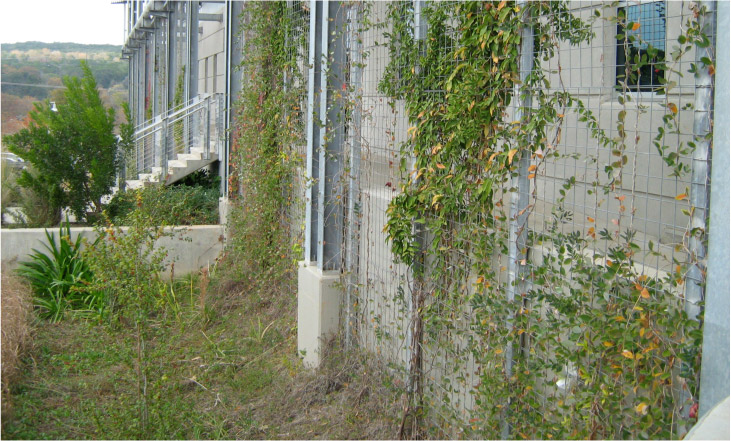
Vegetated trellises can help to shade east-facing walls for cooler interiors. Image credit: Heather Venhaus
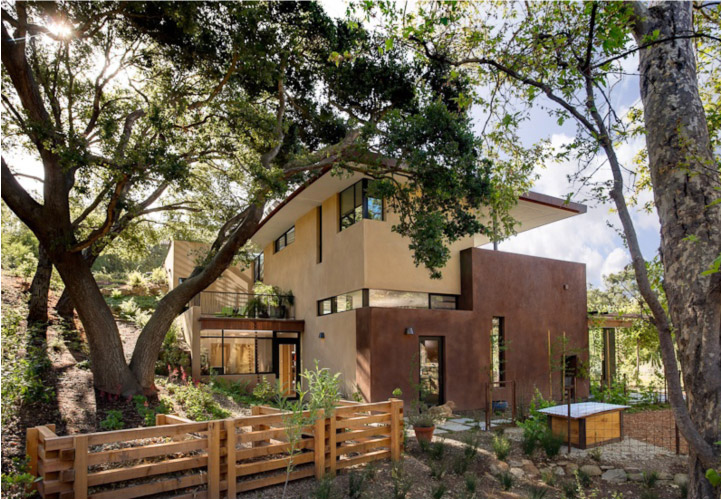
Coyote House in Montecito, California, was designed with conservation in mind; its windows and doors are positioned with plant life to optimize natural temperature control. Image credit: Dorothy Gary Leveille
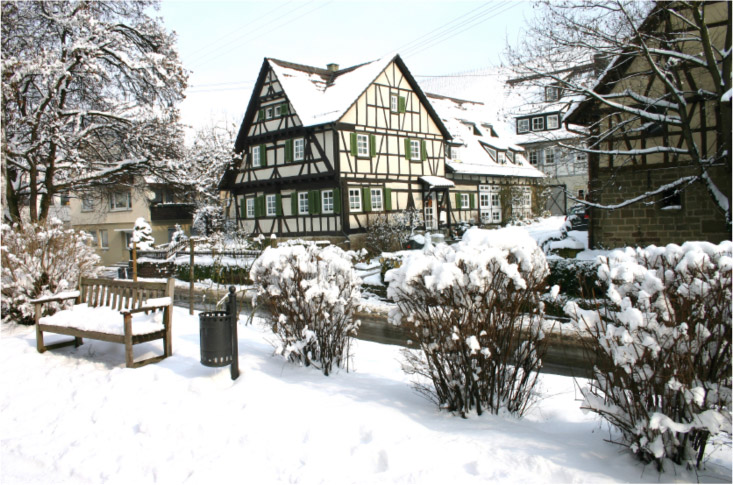
Houses in cold climates can greatly benefit from well-placed windbreaks. Image credit: Microsoft Images
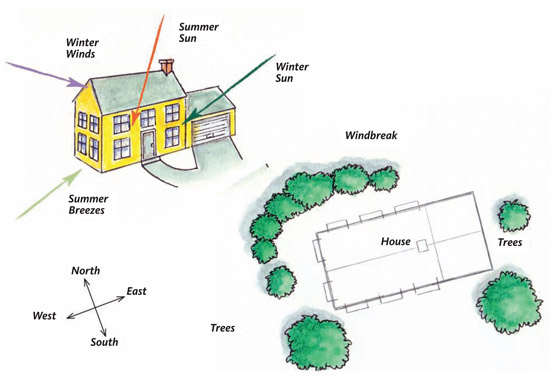
Windbreaks are best positioned between a home and the direction of prevailing winter weather. Image Credit: Landscape For Life

Evergreens make wonderful windbreaks and often offer vegetation close to the ground. Image credit: Landscape For Life
Create an effective windbreak.
Winds make winter cold significantly worse. Although it’s more difficult to use plantings to reduce the brunt of the wind than to shade the sunlight, it is possible to keep a house warmer in winter and reduce energy use by blocking the chilling effects of the wind. The most effective way is to plant a windbreak, a band of evergreen and deciduous trees and shrubs located perpendicular to the prevailing winds. If a property is small, homeowners can plant evergreen shrubs next to the house to create a dead air space that can help insulate the home. Evergreen shrubs can also be strategically located near the house to help shelter doors exposed to the wind.
To be most effective, a windbreak must meet certain requirements. The extent of protection is related to a windbreak’s height and length. For the greatest protection, homeowners should plant windbreaks at a distance from their house of about two to five times the height of the trees when they’re mature. That means that if the trees being planting will grow to 40 feet tall, homeowners should plant them at least 80 feet upwind from the house. When planting windbreaks, vegetation should be located so that it does not prevent sunlight from reaching the house, particularly on the south facing walls between the hours of 9 am and 3 pm.
A good windbreak provides protection in more than one direction. A study in South Dakota found that windbreaks located to the west, north and east of homes cut their fuel consumption by an average of 40 percent. Houses with windbreaks planted only on the windward side, the side of the prevailing winds, averaged 25 percent less fuel consumption than similar but unprotected homes.
The best windbreaks block the wind close to the ground as well as up high, so homeowners should be sure to include species that have low crowns, such as spruces and firs. Evergreen and deciduous trees and shrubs can also be combined with a wall, fence or earth berm to lift the winds up and over the house. Some air should be able to pass through the windbreak. Impenetrable barriers create a strong vacuum on the protected or leeward side, causing some of the wind to whip up over the top and down, hitting the house instead of lofting over it. Windbreaks composed of living plants naturally allow some of the wind to penetrate, which makes them more effective.
A standard multiple row windbreak consists of a windward (upwind) row of dense conifer trees or shrubs, interior rows of tall broadleaf trees, and leeward (downwind) rows of shrubs or conifers. How far apart the trees and shrubs should be planted depends upon the size and shape of the species when they reach maturity, but there should be no gaps between the plants when they are fully grown. Maximizing the diversity of vegetation will improve habitat conditions and reduce the risk disease and insect damage.

